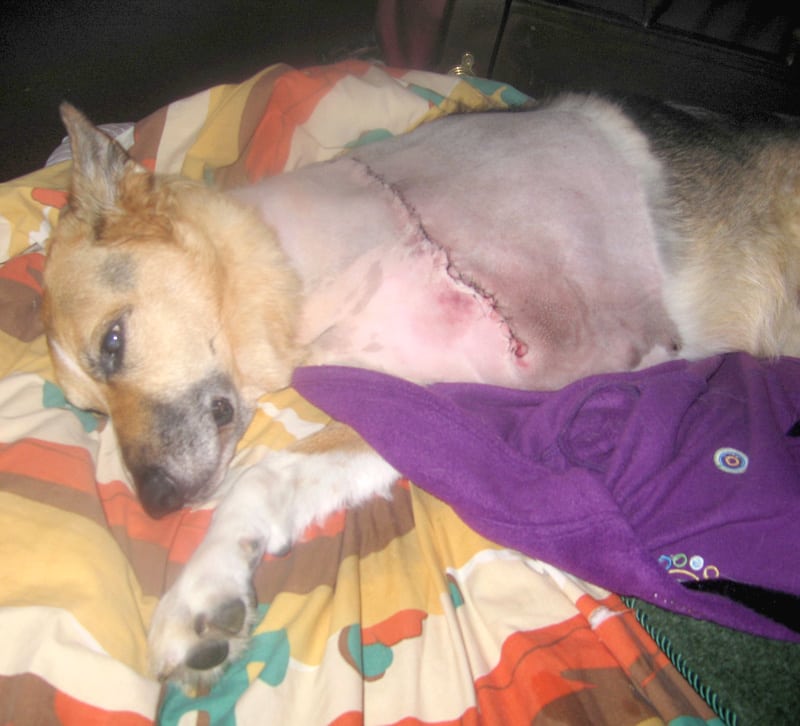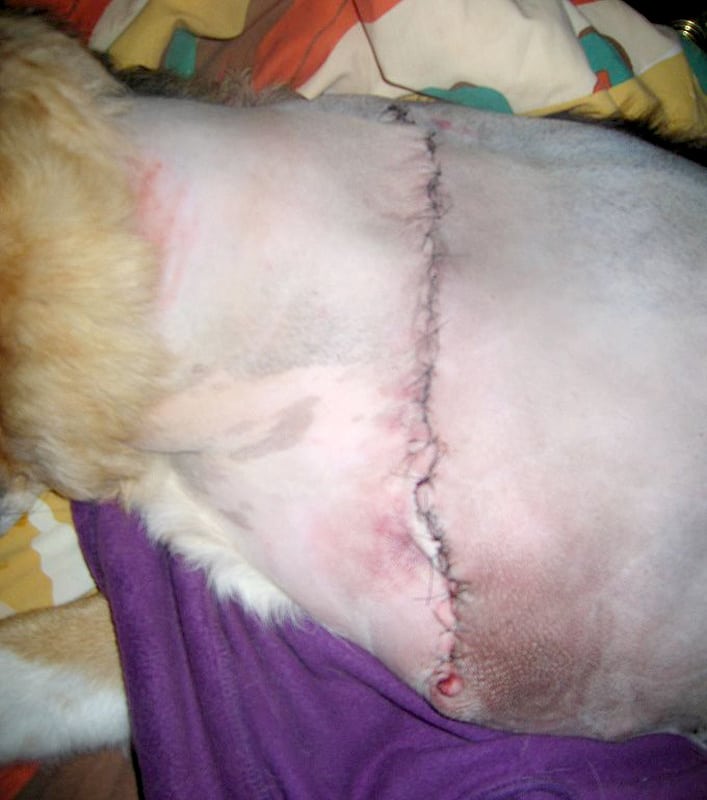Here at Tripawds, we talk about seromas a lot.

But what exactly is a post-op seroma? According to Michigan Veterinary Specialists,
“Seromas may occur at the surgical site. A seroma is an accumulation of fluid in the tissues. The body will usually absorb the fluid, but the fluid is sometimes drained if needed.”

My new Tripawd buddy Titan wants you to know, if your dog is about to undergo amputation surgery, it’s important that you know about seromas. They can occur anytime after a surgery like amputation, spaying, etc., but they are relatively harmless.
According to Northern California’s Veterinary Surgical Associates:
If the region around the incision becomes progressively more swollen, your pet may have a seroma, which is an accumulation of fluid under the skin. This occurs most often with dogs that are very active immediately after surgery.
NEW! UPDATE: Amputation Seroma Swelling Care Tips
Seromas Gone Bad
Titan and his mom have graciously sent us some photos of his really gnarly seroma (warning, these photos are kinda gross!). Lucky boy, he got it taken care of and everything is fine now and he’s well on the road to recovery. Whew!
Other Tripawds members over the years have also submitted photos of dog leg amputation seromas in the Tripawds Galleries gallery to help others know what to expect…
Is Incision Leakage Normal?
Post-op seromas are quite common and some leakage is to be expected. Some vets insert drains to prevent fluid build up. Consider these facts and please contact your vet immediately with any serious concerns.
- Seroma fluid should be white, clear or slightly pinkish in color.
- Bleeding or dark red fluid is not common!
- Foul smelling seepage may be a sign of infection.
- Seromas may feel squishy or appear as saggy skin.
- The body will absorb most serum over time.
- Seromas can be easily drained with a syringe by your vet.
- Bruising around the area is normal and may appear severe.
 Download Tripawds e-books for fast answers to common concerns!
Download Tripawds e-books for fast answers to common concerns!
Suggested Reading:
Amputation Seroma Swelling Care Tips
Post-Amputation Side Effects in Dogs
Amputation Wound Care for Post-Surgery Dogs
Amputation Surgery Suture Reaction in Dogs
Ten Tips for a Tripawd Friendly Home
See Post-Op Photo Gallery for Examples of Seromas & Bruising
Our puppy had his front leg amputated at 14 weeks, almost 3 months ago. He just developed a seroma on his stump, and it became infected. The vet drained it today. Are there steps we should take to prevent a recurrence?
Hi Nettie, sorry to hear that. It’s not terribly unusual for a seroma to happen this late after surgery but the infection is what I would be concerned about. Make sure your vet has the fluid tested for MRSA if it doesn’t clear up with an antibiotic (he should be on one now). Hope your pup gets well soon. Keep us posted in the Discussion Forums.
Hey, my dog had amputation nearly a week ago, he’s skin is becoming extremely red, not around the amputation site but on his belly and down his willy?? Don’t know if this is normal, do you know anything about this?
@Lauren Please consult your vet with any serious concerns. Bruising is very common, and can sometimes get quite ugly. Review the Tripawds Galleries for surgery and treatment pics for comparison, and post in the forums for much more support from others.
How much bleeding is normal from wound area three days after rear leg amputation? Swelling?
Bleeding is not normal. Contact your vet ASAP if you suspect any blood. Some leakage of fluid is to be expected from a seroma, but it should not be dark red. Swelling and bruising are very common. Check out some of the suggested reading links above for helpful information or post in the forums for much more feedback than you’ll in comments here.
My baby girl had a front leg amp and has a huge seroma. We are one week out. Hate seeing her like this 🙁
The seroma can be easily drained by your vet. Take things one day at a time and check the forums and blogs for lots of helpful recovery and care tips or consider downloading the Tripawds e-books for fast answers and feel free to call to toll-free Helpline anytime.
Fawne, try not to be scared. We send our love and healing thoughts to Sasha. If you need any support or just want to talk, please join our Forums, we’re happy to help any way we can. Good luck.
Yes, thanks. I’ve been in tears for 2 hours since I left the vet today and my little Sasha has to have an amputation because her broken leg won’t heal and she’s 13 years old. This is a great site ’cause I’m scared to death and need to just throw myself into everything I can read before I schedule the surgery.
Just an FYI Titan’s seroma did heal even though they had to do sticthes on the under layers of skin. They couldn’t restaple it. But it healed nicely we will see when his fur grows back. If you think your buddy has a seroma be peristant so they can drain it. It has been a month since Titan’s amputation and he is doing GREAT well better than Great. Another great tip is since they couldn’t restaple I used hydrogen peroxide wipes to keep that area clean of infection
Heidi and Titan
Gosh, great post! And, it’s important to show the photos so that people may better understand exactly what a seroma can look like. Thanks to Titan’s mom for sharing those photos!
Love,
Vicki, Blazer & Kimber
Hi,
My little kitty, Tiger had her right front leg amputated and i have monitoring the wound carefully and when i thought she might have some seroma I immediately took her back to the Vet and he confirmed that the muscles gets swollen after surgery and when they shrink again it could ooze some liquid. The liquid was a clear pinkish colour and he said I should not worry too much unless it turn yellow in colour. But I now have the problem of, with her using the kitty litter it becomes stuck to the wound. How can I clean this without irrating the wound or should I leave it be?
Your advice would be appreciated.
Tx.
Mathilda
Thanks for asking Mathilda, and best wishes for Tiger. Please consider posting in the forums for much more feedback from members!
Many members with tri-kitties have recommended using a baby t-shirt or onesie to help protect the incision site from getting soiled.